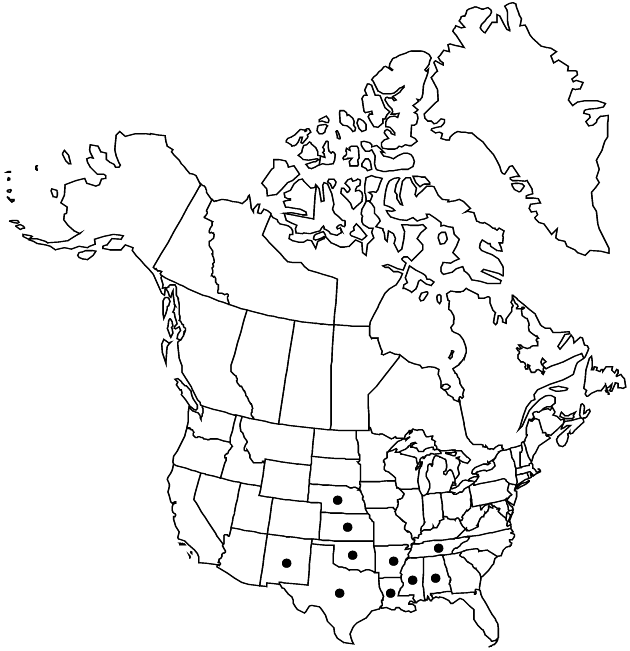familyAsteraceae
genusSymphyotrichum
subgenusSymphyotrichum subg. Astropolium
speciesSymphyotrichum subulatum
Symphyotrichum subulatum var. ligulatum
Sida 21: 907. 2004.
Common names: Saltmarsh or southern annual saltmarsh aster
Basionym: Aster subulatus var. ligulatus Shinners Field & Lab. 21: 159. 1953
Synonyms: Symphyotrichum divaricatum (Nuttall) G. L. Nesom
Treatment appears in FNA Volume 20. Treatment on page 481.
Revision as of 21:00, 29 July 2020 by imported>Volume Importer
Plants (10–) 60–200 cm. Stems usually simple, sometimes branched proximally. Heads 15–120, in open, diffuse arrays, secund on primary branches longer than peduncles. Involucres (5.2–) 6–6.9 mm. Phyllaries 25–45 (–62), subulate to lanceolate, narrow, green zones narrowly lanceolate. Ray-florets 17–30 (–45) in 1 series; laminae lavender to blue, (3.5–) 4.5–7 × 0.9–1.3 mm, longer than pappi, drying in 3–5 coils (apices shallowly lobed). Disc-florets (20–) 33–50; corollas 3.7–4.5 (–5) mm. Cypselae (1.3–) 1.7–2.5 (–2.9) mm; pappi (3–) 3.5–4.6 mm. 2n = 10.
Phenology: Flowering Jul–Nov(–Feb).
Habitat: Marshy habitats, often weedy, roadsides, lawns, waste places
Elevation: 0–1500 m
Distribution
Loading map...

Ala., Ark., Kans., La., Miss., Nebr., N.Mex., Okla., Tenn., Tex., Mexico (Chihuahua), Mexico (Coahuila), Mexico (Tamaulipas)
Discussion
Selected References
None.
Lower Taxa
None.
"thin" is not a number.
... more about "Symphyotrichum subulatum var. ligulatum"
introrse +
connate +
serrulate +
distinct +
herbaceous +
acute;acuminate;acute;acuminate +
scarious +
hirsute +
papillate +
open +
diffuse +
continuous +
withering +
acute;obtuse;acute;obtuse +
entire +
flowering +
indurate +
1.5mm;10mm +
entire +
flowering +
narrowly lanceolate;subulate +
ribbed +
4;8 +
stigmatic +
persistent +
absent +
Saltmarsh or southern annual saltmarsh aster +
at maturity , more or less ampliate , tubes usually shorter +
absent +
5-nerved +
dimorphic +
1.7mm;2.5mm +
ampliate +
staminate +
sessile +
straight +
eglandular +
distinct +
proximal +
1;5 +
bisexual +
dispersed +
in open , diffuse arrays , secund on primary branches longer than peduncles +
singly +
indeterminate +
in open , diffuse arrays , secund on primary branches longer than peduncles +
15;120 +
surrounding +
cylindric;turbinate +
drying +
4.5mm;7mm +
longer +
0.9mm;1.3mm +
alternate +
decurrent +
less spreading;erect +
glabrous +
triangular +
? - ? +
flowering +
strigilloso-ciliolate +
scarious +
foliaceous +
2-carpellate +
inferior +
attached +
anatropous +
barbellate +
white +
persistent +
equal +
diffuse +
tough +
thick +
absent +
connate +
1 - -3-nerved +
persistent +
distinct +
falling +
unequal +
narrow +
withering +
Sida +
2004 +
absent +
sterile +
epaleate +
pitted +
flat;slightly convex +
fibrous +
exalbuminous +
modifed +
pistillate +
fertile +
alternate +
not brittle +
vinelike +
erect +
lanceolate +
2-branched +
glabrous +
Symphyotrichum subulatum var. ligulatum +
Symphyotrichum subulatum +
variety +
at maturity , more or less ampliate , tubes usually shorter +
maturity +
taprooted +
annual +
green +
lanceolate +